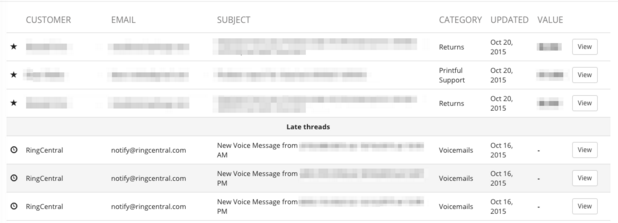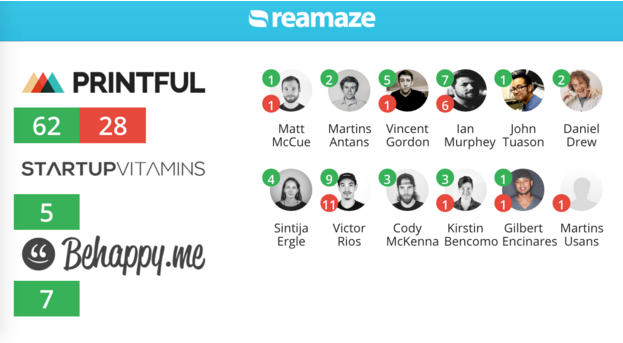The following is a guest post by Julia Gifford from Printful.
The Dark Days
We started out as a modest company. Four people running several internet projects – DeskTime, Startup Vitamins, and Behappy. Any and all support questions would come through to our personal inboxes. The question was read, a solution devised, and an answer dispatched. In the beginning this wasn’t much of a problem – answering a few support questions every day could easily be handled. Problems did come up when we started to grow and support questions began to eclipse our usual email correspondence. Suddenly, it was easier to lose important emails or forget that we were supposed to follow up with a client, especially when consulting with another teammember or department was necessary for those follow ups.
This system – several projects with several inboxes and one conglomerous team managing them all – was fine at first, but lead to more emails “slipping through the cracks” than our vision of stellar, friendly, and prompt communication and customer service allowed.
Enter Reamaze. We were pitched by founders early on to become Beta users. We jumped on. The promise? An easy overview of all of your accounts. Sounded good to us!
Since then we’ve launched an exponentially growing startup called Printful. We have grown to 75 employees across two continents, half of them with their own access to Reamaze. We have 4 brands (tech projects) with even more sub-inboxes, divided into different categories, like email support questions, questions delivered through social media, and even live chat (definitely worth trying – stats show that people are 62% more likely to buy from a store that offers live chat). Across those 4 brands we have an average of about 7,500 support queries per month, so we were in dire need of some order. We found it by using Reamaze.
Here are some untraditional ways to use Reamaze that your company can totally steal from us:
1) Cover 24-hr support by taking advantage of time zone difference
We’re an international bunch, with offices in both the US and Europe. By connecting staff to Reamaze in both continents, we can provide nearly 24hr coverage for our customers. Customers in the States are usually pleasantly surprised when they receive a prompt answer to their late-night query, and that’s thanks to our European team (and, obviously, vice versa). We have the tweets to prove it:
2) Each client gets their own account manager
Basically each customer will have their own account manager who has gotten to know their concerns, profile, and background. Each new customer receive an automated email within 24 hours of registering. When they write in with their first support question, it’ll be to this person. Subsequent questions will always be taken by the same person, so that our team members don’t have to start all over getting to know them, and that leads to a faster resolution. Not to mention the customer doesn’t have to go through their spiel every time, leading to obviously lower frustration rates on the customer end.
3) Cross-departmental involvement in support queries
Not only does Reamaze make communication with our customers easier, it makes communication amongst our departments easier. If there’s ever a thread that needs attention from a particular member of our team or department as a whole, Reamaze makes it possible to keep team conversations within that same thread – nothing gets lost and everyone stays up-to-date on the situation. Our developers will frequently be assigned a ticket by the customer service team if the problem is tech-related. If the ticket is a media inquiry, it’ll be assigned to the Content Marketing team, and so on. Everyone being connected makes everyone responsible for the development of our projects. Not to mention, adding additional representatives, like developers, is affordable and cuts costs by letting the devs talk to customers directly, this solving issues faster for those particularly techy questions.
4) New employee initiation and training
Every new employee will spend a few days getting acquainted with our product and the commonly received questions. This is to get a feel for our customers, who they are, and what’s important to them. A sort of right-of-passage for new employees, it’s a plunge into the company culture, tone, and direction.
Additionally, even top-level managers will jump in every once in a while to reconnect with user problems. Past threads can always be easily retrieved for reference by anyone if need be by simply searching for a keyword, such as a customer’s name or email address. This also comes in handy for training purposes and can always be a good point of reference for complicated issues if one customer has had multiple conversations within multiple Reamaze channels.
5) CRO based on support times + problem identification
Arguably one of the most important features we use is the analytics. Thanks to seeing how many questions are coming in, how many are answered, by whom and how quickly, we’re able to tell a lot. For example, if we’re getting an increase in support questions, chances are something isn’t clear in the website and has to be changed.
We can set tangible goals and we can improve them. We can confidently tell our customers that we answer everything within ONE business day, because analytics tells us that we’re able to do it. We can see who’s working hard, who should be rewarded, and who possibly isn’t quite getting it. Here’s an excerpt of our Response Time Report:
What all of this boils down to is that we improve the trust of our customers by stating a response time and sticking to it, and also keeping track of their questions to identify unclear points or problems in our website. This in turn converts more visitors into paying customers.
6) Revenue-base priority treatment via API
We use the Reamaze API to pull out information to help us identify priority support threads. Customer that have the highest revenue will be pushed to the top of the list, making sure that their support questions are answered first. This is important as in most business, the 80/20 rule is prevalent. 20% of your customers will make up 80% of your revenue. So you have to make sure to take care of those 20%.
Additionally, the API pulls out threads that have been unanswered for more than 24 hours. Since we try to reply to them within 24 hours or less, these become priority and are answered first.
7) Support team leaderboard for accountability
Undeniably having open and available stats on who has answered what how often and how quickly is a great exercise in transparency. That way, they don’t need a manager to pull out some data to see how they’re doing and stacking up to the rest of the team.
We take this even further by pulling out the stats via API and putting them up on a screen, thereby creating a support leaderboard. The green circles represent emails in their inbox that have been there for less than 24 hours. Yellow means they have been there for more than 24 hours, and red means more than 48 hours.
APIs, accountability and long-distance relationships FTW
All in all, we think using Reamze is fun, and even more fun figuring out the different things we can do with it to support us while we grow. Particularly using the API, which can pull out a plethora of interesting stats, and can be used for whatever is important to your business. Plus it’s great to keep everyone accountable, and absolutely mandatory since we’re on separate continents.






